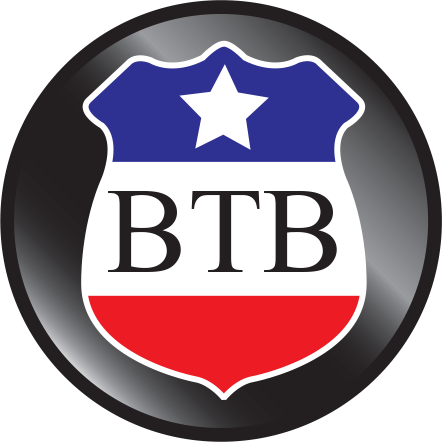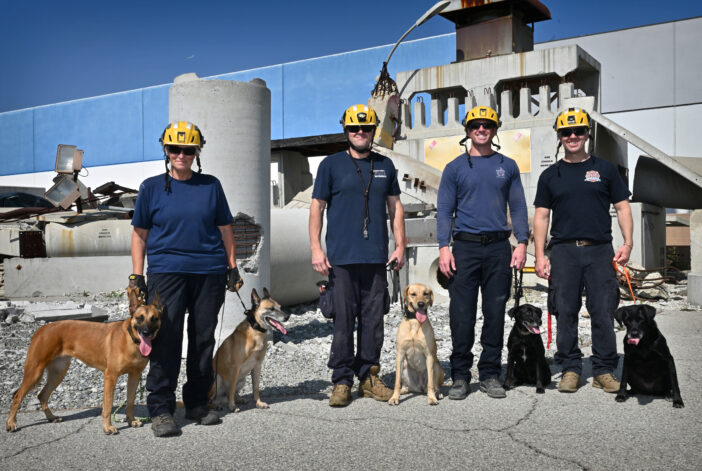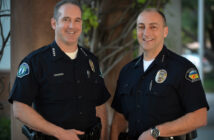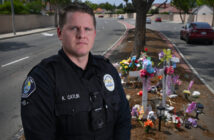A dog’s nose compared to that of a human is night and day, according to Orange County Fire Authority Capt. Michael Patterson.
“They don’t just smell one thing, they smell like every single ingredient, every single thing,” said Patterson, who handles scent detection dog, Kendri, an 8-year-old black Labrador.
A human might walk into a home and smell pizza. But a dog smells so much more.
“When a dog walks into a home, the dog’s like, ‘Oh there’s flour, there’s pepperoni, there’s this kind of cheese. The delivery driver must have been wearing this kind of cologne and wearing these kinds of shoes. The dog’s capability is just unfathomable in comparison,” Patterson said. “The details in a dog’s nose is absolutely incredible, which is why they’re able to do this job.”

Engineer Sean Monville rewards his K9 with a chew toy after finding the human decoy who was hidden in the rubble at the Rio Hondo Fire Academy in Santa Fe Springs during a training.
Photo by Steven Georges/Behind the Badge
It’s why the Orange County Fire Authority (OCFA) — which is part of California Task Force 5 under the Federal Emergency Management Agency (FEMA) — has 14 scent dogs and 11 handlers, including 10 live-find dogs and four human remains dogs.
In October, six K9s (four live-find and two human remains K9s) were sent to the East Coast in support of Hurricanes Helene and Milton. Even more recently, two human remains dogs were sent to the Eaton and Palisades fires, where they found multiple remains.
“Our job is closure and the dogs are able to provide that. They’re able to provide a lot of people the opportunity to know where their family member is or their loved one,” Patterson said. “It’s pretty phenomenal to be a part of that… We’re an available resource 24-7.”

Capt. Mike Patterson rewards his K9, Kendri, during a training after finding the human decoy who was hidden in the rubble at the Rio Hondo Fire Academy in Santa Fe Springs.
Photo by Steven Georges/Behind the Badge
The dogs
Most of the dogs on the OCFA K9 team are rescues. The OCFA gets their search dogs through a nonprofit organization in Ventura called the Search Dog Foundation.
“Some of the handlers do get their own dogs and will train their own dogs,” he said. “As Orange County firefighters, we get our dogs through the foundation. … They actually get their dogs from all over the United States.”
Most of the dogs on the Orange County team are long-nosed like Labrador retrievers, Belgian malinois and German shepherds. Some are purebreds like human remains dogs K9 Rubble, who is an 8-year-old male Labrador, and 7-year-old female Labrador K9 Mazie — but most of them are not.

Nanci, a rescue K9 with OCFA Engineer Sean Monville, searches the rubble for a human decoy during training at the Rio Hondo Fire Academy in Santa Fe Springs.
Photo by Steven Georges/Behind the Badge
“My dog came from Sioux Falls, South Dakota,” said Patterson. “It was running the streets. It was brought in by the pound, taken to a shelter. The shelter called the foundation. They were like, ‘Yeah the dog looks great, bring ’em over.’”
The main thing the foundation looks for is drive.
“It has to have endless drive where no matter what gets in its way, it is driven to find, in this situation — a toy,” Patterson said. “A lot of dogs, you throw a toy once and they’re excited to bring it back. You throw a toy a second time, and they may or may not bring it back.
“My dog, I could throw the toy for an hour and she would continue to bring it back until she’s physically incapable of moving. And that’s the big thing that they look for.”

Nanci, a rescue K9 with OCFA Engineer Sean Monville, searches the rubble for a human decoy during training at the Rio Hondo Fire Academy in Santa Fe Springs.
Photo by Steven Georges/Behind the Badge
They want the dog that’s going to traverse that field back and forth endlessly. But there are other important factors as well, including aggression.
“We don’t want to have two dogs out here and they start attacking each other,” he said. “We don’t want to send a dog in for a search and they end up biting someone else.”
They are looking for dogs who search for a person because they know once they find that person, they’ll be given their toy.
“And then it’s a celebration that they found the person,” Patterson said.

Engineer Sean Monville rewards his K9, Nanci, after finding the human decoy who was hidden in the rubble at the Rio Hondo Fire Academy in Santa Fe Springs during a training activity.
Photo by Steven Georges/Behind the Badge
For Kendri, it’s a hose toy with a lanyard on it. Once Kendri finds the missing person, Patterson grabs one end and Kendri gets the other.
“It’s the interaction between with the toy and the person,” he said. “That’s really the reward is the celebration of the toy.”
The training
There are two tests each K9-handler team must past in order to become a FEMA-certified handler. One 15-part test is called an FSA, which is all about obedience. Once they pass that portion, then they proceed to the FEMA certification test.
Most of the K9 team’s regular training revolves around this FEMA certification test. During training, 50 percent of the time they know where the victims are and 50 percent of the time they try not to know. For the actual test, they don’t know where any of the victims are located.

Xero, a rescue K9, searches the rubble for a human decoy during a training exercise as Julie Purcell, Reserve Firefighter and K9 handler with California Fire Task Force 5, watches her progress.
Photo by Steven Georges/Behind the Badge
When a new handler gets a dog, he or she goes to the foundation’s Ventura facility for about six months of training. After that, the training continues.
“The dogs come to us anywhere from 60 to 80 percent trained — they know how to search, they know obedience, they know a lot of things like that,” he said. “It’s our job to… bring them up to 100 percent in order to pass the tests.”
Handlers have to re-certify every three years for FEMA.
“We have seven scheduled search trainings per month. As handlers we have a team rule that you must attend at least four trainings per month,” he said. “We try never to train at the same facility twice in the same month.”

Xero, a rescue K9, searches the rubble for a human decoy during a training exercise as Julie Purcell, Reserve Firefighter and K9 handler with California Fire Task Force 5, watches her progress.
Photo by Steven Georges/Behind the Badge
It’s all to provide a variety of challenges to the dogs to be ready when needed.
“If you go to the same place every single time, there’s only a certain amount of holes that you can put people into,” he said. “The dogs are going to know where the victims are.”
There are currently six Orange County firefighters, one Long Beach firefighter, and four civilian handlers on the team. There are three handlers that have two dogs.
“There are eight Task Forces in California and we rotate every month,” he said. “Depending on when a natural disaster occurs will depend on what Task Force is first up in that situation.”

Xero, a rescue K9, barks after finding the human decoy hidden in a van at the Rio Hondo Fire Academy in Santa Fe Springs.
Photo by Steven Georges/Behind the Badge
Until that time comes, they’re training — and always with their dogs.
“Those of us that are full-time firefighters, the dogs are with us 24-7,” he said. “They’re in the firehouse with us, they’re at home with us. They go on vacation with us. They’re with us more than our kids are with us.”
Even when not in structured training, there’s still some kind of training happening.
“A lot of us have different training programs for the dogs for just general fitness,” he said, “very similar to like what you would find at the gym. Unstable things that they have to balance on. We’ll have them jump up on the tables just to keep their fitness and strength and flexibility up.”

Julie Purcell, Reserve Firefighter and K9 handler with California Fire Task Force 5 (CA-TF5), rewards her K9, Xero (pronounced “Zero”), after finding a human decoy during training at the Rio Hondo Fire Academy in Santa Fe Springs.
Photo by Steven Georges/Behind the Badge
A variety of surfaces, loud noises, critters, other dogs barking, cats and food are all part of training too.
“One of the things that we train on is food. We’ll put food out on the pile to see if it distracts the dogs,” Patterson said. “If we’re on a disaster and multiple houses were knocked down and we’re looking for people … it’s homes. There’s going to be food…There’s going to be all kinds of things. We don’t want our dog to be like ‘Oh, let’s go get a hamburger real quick before I find the person.’”
Dogs can be afraid of unstable platforms or unstable footing, heights, or dark areas.

Julie Purcell, Reserve Firefighter and K9 handler with California Fire Task Force 5 (CA-TF5), places her K9, Xero, in a comfortable cage after a successful training exercise.
Photo by Steven Georges/Behind the Badge
“At least every other if not every third month, we try to have a night drill,” he said. “We train 12 months out of the year regardless of the weather. Rain is not easy … the most difficult weather to train in is wind.
“The dogs pick up scent based on the wind. If you have Santa Ana winds going 50 to 60 miles an hour, that scent moves very quick,” he said.
There are added benefits of spending so much time with dogs. Patterson, who works out of Westminster Station 64, said everyone at the firehouse loves Kendri.
“Having a dog around, it just changes … just your whole persona,” he said. “You could have a bad call, or just having a bad day and you let the dog out — she’s running around the firehouse, everyone suddenly is happier, everyone’s excited, everyone wants to pet her, wants to throw her toy. She does more than just search. She definitely increases the morale around the firehouse, overall well-being of everyone.”

Capt. Mike Patterson with Kendri, left, Capt. Tyler Green with K9 Mila, Engineer Sean Monville with Nanci, and Reserve Firefighter of California Fire Task Force 5 with her K9’s Xero and Keres, right, after a training session at the Rio Hondo Fire Academy in Santa Fe Springs.
Photo by Steven Georges/Behind the Badge
 Behind the Badge
Behind the Badge





